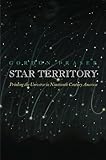Star Territory : Printing the Universe in Nineteenth-Century America / Gordon Fraser.
Material type: TextSeries: Material TextsPublisher: Philadelphia : University of Pennsylvania Press, [2021]Copyright date: ©2021Description: 1 online resource (264 p.) : 11 halftones, 7 tablesContent type:
TextSeries: Material TextsPublisher: Philadelphia : University of Pennsylvania Press, [2021]Copyright date: ©2021Description: 1 online resource (264 p.) : 11 halftones, 7 tablesContent type: - 9780812297904
- Astronomical literature -- United States -- History -- 19th century
- Astronomy and state -- United States -- History -- 19th century
- Astronomy -- Political aspects -- United States -- History -- 19th century
- Astronomy -- United States -- History -- 19th century
- History-United States
- Literature (Scholarly)
- HISTORY / United States / 19th Century
- American History
- American Studies
- Cultural Studies
- General
- Literature
- Science
- 303.48/3097309034 23
- QB33.U6 F73 2021
- online - DeGruyter
| Item type | Current library | Call number | URL | Status | Notes | Barcode | |
|---|---|---|---|---|---|---|---|
 eBook
eBook
|
Biblioteca "Angelicum" Pont. Univ. S.Tommaso d'Aquino Nuvola online | online - DeGruyter (Browse shelf(Opens below)) | Online access | Not for loan (Accesso limitato) | Accesso per gli utenti autorizzati / Access for authorized users | (dgr)9780812297904 |
Frontmatter -- Contents -- Introduction -- Chapter 1. Almanacs in the Astronomical Nation -- Chapter 2. The Emancipatory Cosmology of the First Black Press -- Chapter 3. Cherokee Astronomy -- Chapter 4. The National Almanac in Peace and War -- Chapter 5. Hawaiian Cosmography in Print -- Epilogue. The Third Space Age -- Notes -- Bibliography -- Index -- Acknowledgments
restricted access online access with authorization star
http://purl.org/coar/access_right/c_16ec
The United States has been a space power since its founding, Gordon Fraser writes. The white stars on its flag reveal the dream of continental elites that the former colonies might constitute a "new constellation" in the firmament of nations. The streets and avenues of its capital city were mapped in reference to celestial observations. And as the nineteenth century unfolded, all efforts to colonize the North American continent depended upon the science of surveying, or mapping with reference to celestial movement. Through its built environment, cultural mythology, and exercise of military power, the United States has always treated the cosmos as a territory available for exploitation.In Star Territory Fraser explores how from its beginning, agents of the state, including President John Adams, Admiral Charles Henry Davis, and astronomer Maria Mitchell, participated in large-scale efforts to map the nation onto cosmic space. Through almanacs, maps, and star charts, practical information and exceptionalist mythologies were transmitted to the nation's soldiers, scientists, and citizens.This is, however, only one part of the story Fraser tells. From the country's first Black surveyors, seamen, and publishers to the elected officials of the Cherokee Nation and Hawaiian resistance leaders, other actors established alternative cosmic communities. These Black and indigenous astronomers, prophets, and printers offered ways of understanding the heavens that broke from the work of the U.S. officials for whom the universe was merely measurable and exploitable.Today, NASA administrators advocate public-private partnerships for the development of space commerce while the military seeks to control strategic regions above the atmosphere. If observers imagine that these developments are the direct offshoots of a mid-twentieth-century space race, Fraser brilliantly demonstrates otherwise. The United States' efforts to exploit the cosmos, as well as the resistance to these efforts, have a history that starts nearly two centuries before the Gemini and Apollo missions of the 1960s.
Mode of access: Internet via World Wide Web.
In English.
Description based on online resource; title from PDF title page (publisher's Web site, viewed 01. Dez 2022)


